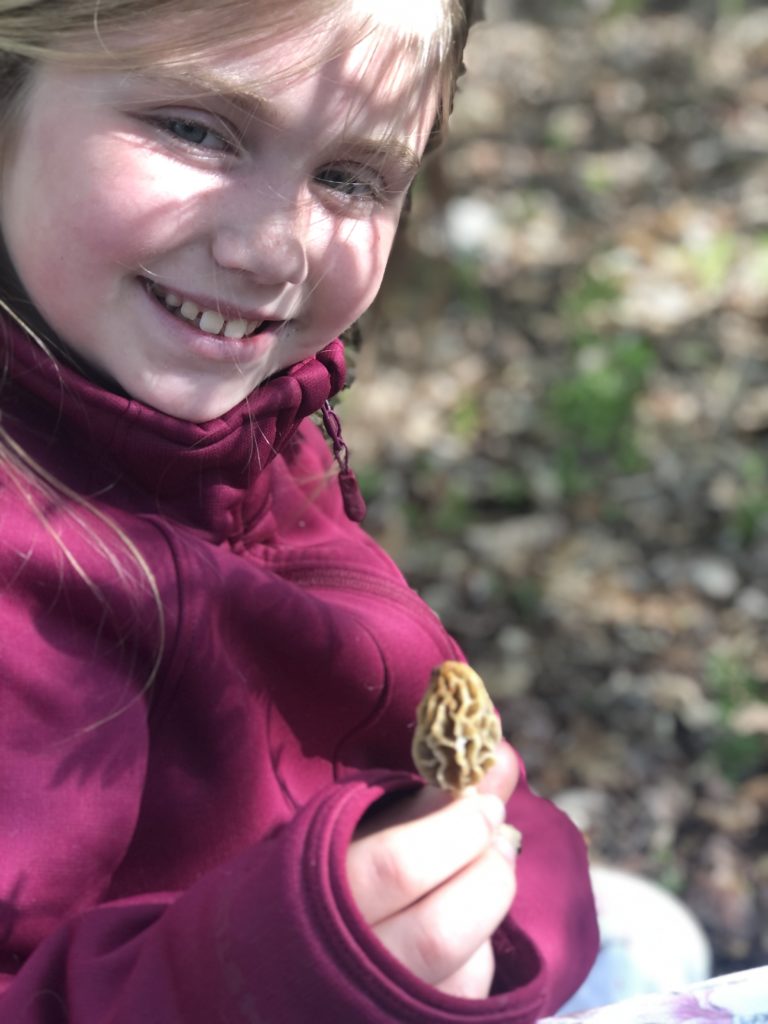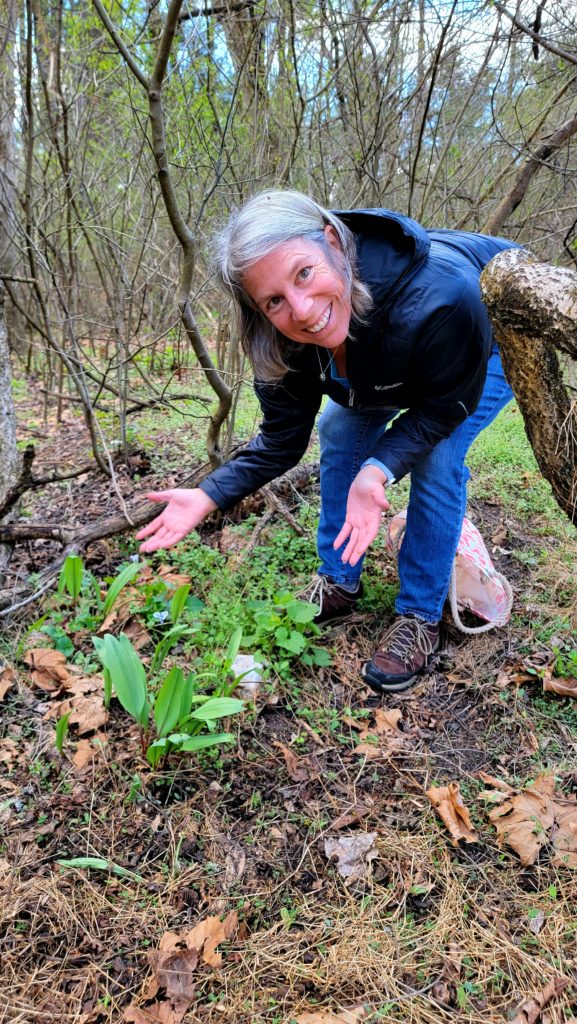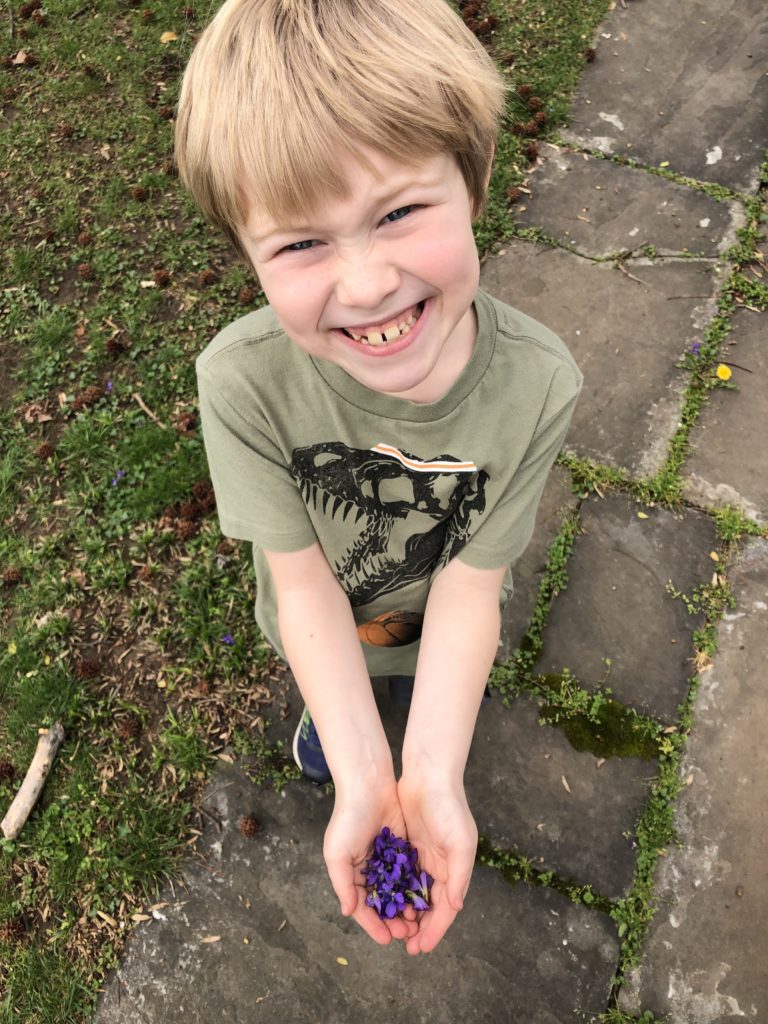Nature’s Garden

Edible wonders are growing all around
By Duffy Perkins
For Capt. Jennifer Kaye, the 40-hour workweek is spent on the water, where she helms a schooner rather than sitting at a desk. For the last 29 years, she and her family have operated the Schooner Woodwind out of Annapolis Harbor, where they lead thousands of passengers each year on charter sailing adventures on the Chesapeake.
But in the spring of 2020, when the coronavirus pandemic temporarily made a landlubber out of Kaye, she found herself in new territory. “It was very strange,” she says. “We didn’t know if we were going to launch the boats and start our season. The boatyards were closed, and we just had to wait.”
After spending the greater part of her life outdoors, Kaye found it difficult to remain inside. So she started going for long walks, and spending time in her own yard. It was there that she began to see the forest for the trees.
“I realized that 90 percent of my lawn is edible,” she says. “As soon as I realized this, I started to think, ‘Hmm, but will it be tasty?’”
The answer was yes.
Kaye started experimenting with making elaborate salads and exotic pesto out of dandelion greens and chickweed. Harvesting magnolia blossoms during the early spring, she made a simple syrup to augment a white wine sangria. Wild violets went into a white balsamic vinegar and became a gorgeous salad dressing. Forsythia blossoms up-leveled a basic honey drizzle.
These plants were readily available within Kaye’s own perimeter, but the more she explored with plants, the more she wanted to explore nature to see what else she could harvest.
“I really wanted to find some morels,” she says, talking about the elusive spring mushrooms. “But they weren’t anywhere I looked. One day, my boyfriend said, ‘I hear they like poplar trees,’ so we went looking for a poplar grove. And sure enough, right there we found four giant morels.”

Kaye’s partner lives on a former working farm, which is where she does most of her foraging. During the pandemic, however, she broadened her scope to places she wouldn’t normally consider. Pineapple weed (extremely hard to find) was found growing in an abandoned parking lot. “It lives where nothing else wants to live,” she says. “It’s not good to forage in parking lots, but during the pandemic, when parking lots were empty all of the time, I wasn’t deterred.”
Where you forage is just as important as what you forage. “My kids and I love dandelions,” says Jesse Iliff, executive director at Severn River Association. “We moved into a new house, and my daughter brought in some of the flowers for me to fry up. I realized she had picked them near the road, and I didn’t know what was coming off that road,” he says. “I wasn’t comfortable eating them.”
Iliff, who has worked as an environmental attorney, naturalist, and Riverkeeper, also became interested in foraging at the beginning of the pandemic. “I was becoming nervous about supply chain issues, so I started to think, ‘What’s out there?’” Iliff used the Seek app from iNaturalist to identify and catalog the plants growing in his yard and on his family’s 100-acre farm on the Severn River, and consulted a blog called The Forager Chef for ideas on how to prepare everything from dandelion greens to lion’s mane mushrooms.
“The lion’s mane I found on my family’s farm, and I found a YouTube video on how to prepare them like crabcakes. Now, I’m a born and bred Marylander, so this is a bold statement: they were so good. My kids ate some and had no idea they were mushrooms.”
Iliff prefers foraging on his family’s farm for good reason. The official notice on harvesting any plant or animal in public places is spelled out clearly: “In Maryland State Parks and Forest, foraging is not allowed: an individual may not remove, disturb, damage, or destroy a plant, rock, mineral, or animal without a permit.”
This law exists for a good reason, Iliff says. “The more you harvest native species from a forest, the more the invasive species get a leg up.”
Forests that are overrun with invasives suffer greater problems with ticks, less biodiversity, and more general problems with both flora and fauna. The good news is that park rangers are beginning to see the benefit of getting the foraging community involved in ecological activism, and so foraging events are becoming more popular within state parks and forests.
To counter the possible destruction of harvesting flora on your own, Iliff suggests considering the impact of taking something before heading out. “Native plants belong here, as part of the ecosystem. Well-meaning foragers often take the whole plant, rather than just one part, which doesn’t allow the species to replenish itself.”
Iliff mentions ramps, a golden child of the foraging world, as an example. “Ramps are edible from root to leaf, like any other allium. But they’re becoming increasingly rare, as people over harvest them. There are ethical ways to do it, taking one leaf from each plant. When you harvest the bulb, you take the entire plant with you.”
At Patapsco Valley State Park, foraging is permitted as long as visitors do not remove the entire plant material and agree to take only what they need for themselves and not sell their harvests. Virginia Gambrell works in the park’s visitor services area and is a forager herself. “We’ve experienced roughly a 50 percent increase in visitorship over last year,” she says, “and many visitors have an active interest in self-reliance and sustainability, and come to the park looking to forage.” Gambrell notes that mushrooms and pawpaws are the most popular things to harvest, but that this also comes with a dark side.
“The biggest problem is that foraging encourages visitors to walk off the trails, and they may not realize they’re encouraging the spreading of invasive species,” she says. “We have several fields of basket grass, and as visitors walk through the field to forage, the basket grass seeds will become attached to their clothes and shoes, and be transmitted throughout the park. We simply ask visitors to be enthusiastic but also respectful to nature when they come into the park.”
One way to help encourage and rebuild a forest’s natural ecosystem is to forage for invasive species. Kaye’s new favorite invasive is perilla (often called shiso, or Japanese basil), a traditional Asian crop that belongs in the mint family (“It tastes like a cross between cinnamon and mint,” she says). While perilla was first identified in China around 500 CE, the leaves only made it to Western gardens in the 19th century. Today, the plants can be found growing extensively in marshy areas, and likely your backyard. The leaves make fantastic wrappers for rice and fish, but can also be used in salads and chimichurris.
Knotweed is another invasive that can become a culinary adventure. A member of the buckwheat family, knotweed was introduced to the United States in the 19th century as an ornamental plant and was used to prevent erosion. However, once established, knotweed can spread rapidly. Young shoots have a bamboo-like texture with a taste similar to a cross between asparagus and rhubarb, making it a fun addition to pies or jams. “I like it best pickled,” says Iliff. “But you have to get it in the spring, when they are tender little shoots with a little red to them. If you try eating them in the summer, when they’re 7- or 8-feet tall, it’s like eating a two-by-four.”
Whether you’re a new forager or a highly experienced harvester, the most important thing to remember is that the best part of foraging is spending time in nature. Even if your basket comes home empty, a good walk in the woods is always worth it.
Want to start harvesting? Start here!
One of the easiest and best tasting things to harvest is dandelions. The greens complement any salad. Try mixing dandelion leaves in with a spring mix or kale blend, then topping with a simple Caesar dressing. The flowers can be deep fried as nuggets and go well with a spicy jelly.
Those tiny purple violets all over your yard? They’ll brighten any salad or soup, but put a big handful of the purple leaves into a jar of white balsamic vinegar, cover, and store in a dark area for two weeks to achieve a gorgeous purple hue for your next vinaigrette.
Garlic mustard is also plentiful. Spicy and nutritious, garlic mustard is an invasive plant that you can feel good about eating. Using a blender, pulse two cups of leaves with garlic, roasted walnuts or almonds, olive oil and pecorino cheese to make a “local pesto” your family and friends will enjoy. Layer on top of pasta or dip bread in it for a lively riff on a classic.
Morels have a truffle-like quality to them and are perfect on white pizza. Top a flatbread with mozzarella or burrata along with fresh rosemary, sea salt, and olive oil, then let the morels crisp up under the broiler. Top generously with parmesan cheese for a finish to die for.
Want more recipes? The Maryland DNR has published an online cookbook called Wild Maryland cataloging various recipes for wild game, seafood, and foraged flora. While “Buffalo Squirrel Sticks” may not be on your ideal menu, the cookbook has great recipes for pickled ramps, dandelion greens with bacon, and morel cacio e pepe.
Some Good Apps for Foraging
Seek by iNaturalist
Originally developed by National Geographic and the California Academy of Sciences, the Seek app uses your phone’s camera to easily identify thousands of different types of flora and fauna. An added bonus is the ability to use the geo-locator to identify the species that have been observed around you, as well. The app includes fun badges and challenges for adults and kids alike.
PictureThis
With over 10,000 archived images in its database, the PictureThis app puts the knowledge of an amateur botanist in your to-go bag. This app is praised for its accuracy, and allows you to store images in your “garden” to make self-identifying even easier. PictureThis app is not specifically designed for foraging, so be sure to double- and triple-check everything with other sources before anything goes in your mouth.
WildEdibles
Specifically developed for foraging, WildEdibles is the creation of “Wildman” Steve Brill, an environmental educator out of New York. The app is a great guide for identifying, cultivating, and preparing plants, but is not as extensive in its library as others. This app is targeted toward foragers in the eastern states, and organizes species by habitat, season, and more.
Forager Diary
There’s a serious amount of secrecy around foraging: once you’ve found that envious morel hot spot, you want to be able to go back year after year. Forager Diary allows you to keep track of the spots in a secure way, without sharing information socially.

Before you take anything out of the ground, remember a few things:
1. Look where you’re foraging. Is the ground treated with any form of pesticide application? Is there significant runoff from a road? If anything about the area is questionable, don’t eat that!
2. Double- and triple-check your plant or fungus before you harvest it. “Any mushroom is edible once,” says Iliff. Don’t hesitate to post images of your harvest on social media to ask for help identifying before you eat anything. And if there are any questions, don’t eat that!
3. Make sure your plant is healthy. If you see any forms of distress to the plant body, don’t eat that!
4. Always consume small amounts of the plant first to make sure you don’t have an allergic reaction. If anything feels off, don’t eat any more of that!
5. And finally, mix your foraged food in with grocery store food. Foraged plants have more minerals and nutrients than mass-produced food, and may affect your digestive system if you consume too much too soon.
